Numerical Study on Solidification Behavior and Structure of Continuously Cast U71Mn Steel
Abstract
:1. Introduction
2. Model Descriptions
2.1. Basic Assumptions
- (1)
- Heat transfer along the casting direction is ignored as it occurs much less in comparison to the heat transfer in the direction along the cross-sectional during the continuous casting process of round blooms.
- (2)
- For the existence of interspace between the mold and bloom, the heat transfer in the mold can be calculated by the average heat flux.
- (3)
- The effect of the fluid flow of molten steel on the internal heat transfer and structure is ignored during the calculations.
- (4)
- Given that there is uniform heat transfer in each part of secondary cooling zone, the heat exchange of the bloom in the secondary cooling zone can be described by the heat transfer coefficient.
2.2. Governing Equations
2.2.1. Thermal Transport
2.2.2. Heterogeneous Nucleation
2.2.3. Kinetics of Dendritic Tip Growth
3. Simulation Procedures and Model Validation
3.1. Model Building
3.2. Casting Conditions and Parameters
3.3. Initial and Boundary Conditions
3.4. Model Validation
3.4.1. Validation of Heat Transfer
3.4.2. Validation of Solidification Structure
4. Results and Discussion
4.1. Effect of Secondary Cooling Types
4.2. Effect of Superheat
5. Conclusions
- (1)
- The simulated results of the solidified shell, solidification structure distributions and equiaxed grain size are basically consistent with the nail shooting, macro etch experiments and OM observations; errors in the shell thickness are controlled within 4%.
- (2)
- Compared to the slow cooling condition, the solidification end of the bloom is 2.46 m longer and the length of the bloom center mushy zone increases by about 1.46 m under the super-slow cooling condition. However, the bloom surface and corner temperatures are higher, and the degree of temperature rise when entering air-cooling zone is much smaller. Furthermore, the solidification structure shows little change under these two secondary cooling conditions.
- (3)
- As the superheat increases, the average grain size increases, while there is an apparent decrease in the percentage of center-equiaxed grains. When the superheat increases from 15 to 40 K, the center-equiaxed grain ratio decreases from 44.6% to 20.1% and the grain average radius increases from 1.025 to 1.128 mm. The difference in grain size between 15 and 20 K is tiny. A step size increase in the superheat of 5 K causes an increase of only about 0.19 m in the solidification end length, and an increase of 3 K in the surface temperature. The super heat should be controlled within 20 K.
Acknowledgments
Author Contributions
Conflicts of Interest
References
- Yamazaki, M.; Natsume, Y.; Harada, H.; Ohsasa, K. Numerical simulation of solidification structure formation during continuous casting in Fe-0.7 Mass% C alloy using cellular automaton method. ISIJ Int. 2006, 46, 903–908. [Google Scholar] [CrossRef]
- Straffelini, G.; Lutterotti, L.; Tonolli, M.; Lestani, M. Modeling solidification structures of steel round billets obtained by continuous casting. ISIJ Int. 2011, 51, 1448–1453. [Google Scholar] [CrossRef]
- Anand, G.; Datta, S.; Chattopadhyay, P.P. Deterministic approach for microstructurally engineered formable steel. Int. J. Metall. Eng. 2013, 2, 69–78. [Google Scholar]
- Nastac, L. A 3D stochastic mesoscopic model for prediction of, structure evolution during solidification of dendritic alloys. Metall. Res. Technol. 2014, 111, 311–319. [Google Scholar] [CrossRef]
- Rezende, J.; Senk, D.; Hüttenmeister, D. Phase-field modeling of the dendrite growth morphology with influence of solid-liquid interface effects. Steel Res. Int. 2015, 86, 65–72. [Google Scholar] [CrossRef]
- Rappaz, M.; Gandin, C.A. Probabilistic modelling of structure formation in solidification processes. Acta Mater. 1993, 41, 345–360. [Google Scholar] [CrossRef]
- Gandin, C.A.; Desbiolles, J.L.; Rappaz, M.; Thevoz, P. A three-dimensional cellular automation-finite element model for the prediction of solidification grain structures. Metall. Mater. Trans. A 1999, 30, 3153–3165. [Google Scholar] [CrossRef]
- Zhu, H.; Jiang, Z.; Li, H.; Zhu, J.; Feng, H.; Zhang, S.; Zhang, B.; Wang, P.; Liu, G. Effect of solidification pressure on compactness degree of 19Cr14Mn0.9N high nitrogen steel using CAFE method. Steel Res. Int. 2017, 88, 1600509, in press. [Google Scholar] [CrossRef]
- Zhang, H.; Zhang, L. Modeling on the solidification structure of Fe-Ni-based alloys using cellular automaton method. Metall. Res. Technol. 2016, 113, 410. [Google Scholar] [CrossRef]
- Song, W.; Zhang, J.; Wang, S.; Wang, B.; Han, L. Simulation of solidification structure of Fe-6.5% Si alloy using cellular automaton-finite element method. J. Cent. South Univ. 2016, 23, 2156–2164. [Google Scholar] [CrossRef]
- Luo, Y.Z.; Zhang, J.M.; Wei, X.D.; Xiao, C.; Hu, Z.F.; Yuan, Y.Y.; Chen, S.D. Numerical simulation of solidification structure of high carbon SWRH77B billet based on the CAFE method. Ironmak. Steelmak. 2013, 39, 26–30. [Google Scholar] [CrossRef]
- Zeng, J.; Chen, W. Effect of secondary cooling conditions on solidification structure and central macrosegregation in continuously cast high-carbon rectangular billet. High Temp. Mater. Process. 2015, 34, 577–583. [Google Scholar] [CrossRef]
- Bai, L.; Wang, B.; Zhong, H.; Ni, J.; Zhai, Q.; Zhang, J. Experimental and numerical simulations of the solidification process in continuous casting of slab. Metals 2016, 6, 53. [Google Scholar] [CrossRef]
- Hou, Z.; Cheng, G.; Jiang, F.; Qian, G. Compactness degree of longitudinal section of outer columnar grain zone in continuous casting billet using cellular automaton-finite element method. ISIJ Int. 2013, 53, 655–664. [Google Scholar] [CrossRef]
- Fang, Q.; Ni, H.W.; Wang, S.J.; Zang, H. Numerical simulation on the solidification structure of Ø600 mm continuous casting round bloom. IOP Conf. Ser. Mater. Sci. Eng. 2016, 117, 012036. [Google Scholar] [CrossRef]
- Lally, B.; Biegler, L.; Henein, H. Finite difference heat transfer modeling for continuous casting. Metall. Mater. Trans. B 1990, 21, 761–770. [Google Scholar] [CrossRef]
- Gandin, C.A.; Rappaz, M. A coupled finite element-cellular automaton model for the prediction of dendritic grain structures in solidification processes. Acta Metall. Mater. 1994, 42, 2233–2246. [Google Scholar] [CrossRef]
- Kurz, W.; Giovanola, B.; Trivedi, R. Theory of microstructural development during rapid solidification. Acta Mater. 1986, 34, 823–830. [Google Scholar] [CrossRef]
- Long, M.J.; Chen, D.F.; Wang, Q.X.; Luo, D.H.; Han, Z.W.; Liu, Q.; Gao, W.X. Determination of CC slab solidification using nail shooting technique. Ironmak. Steelmak. 2012, 39, 370–377. [Google Scholar] [CrossRef]
- Qu, T.; Wang, S.; Feng, K. Numerical simulation on solidification structure of bloom during continuously casting process. Contin. Cast. 2013, 1, 7–11. (In Chinese) [Google Scholar]
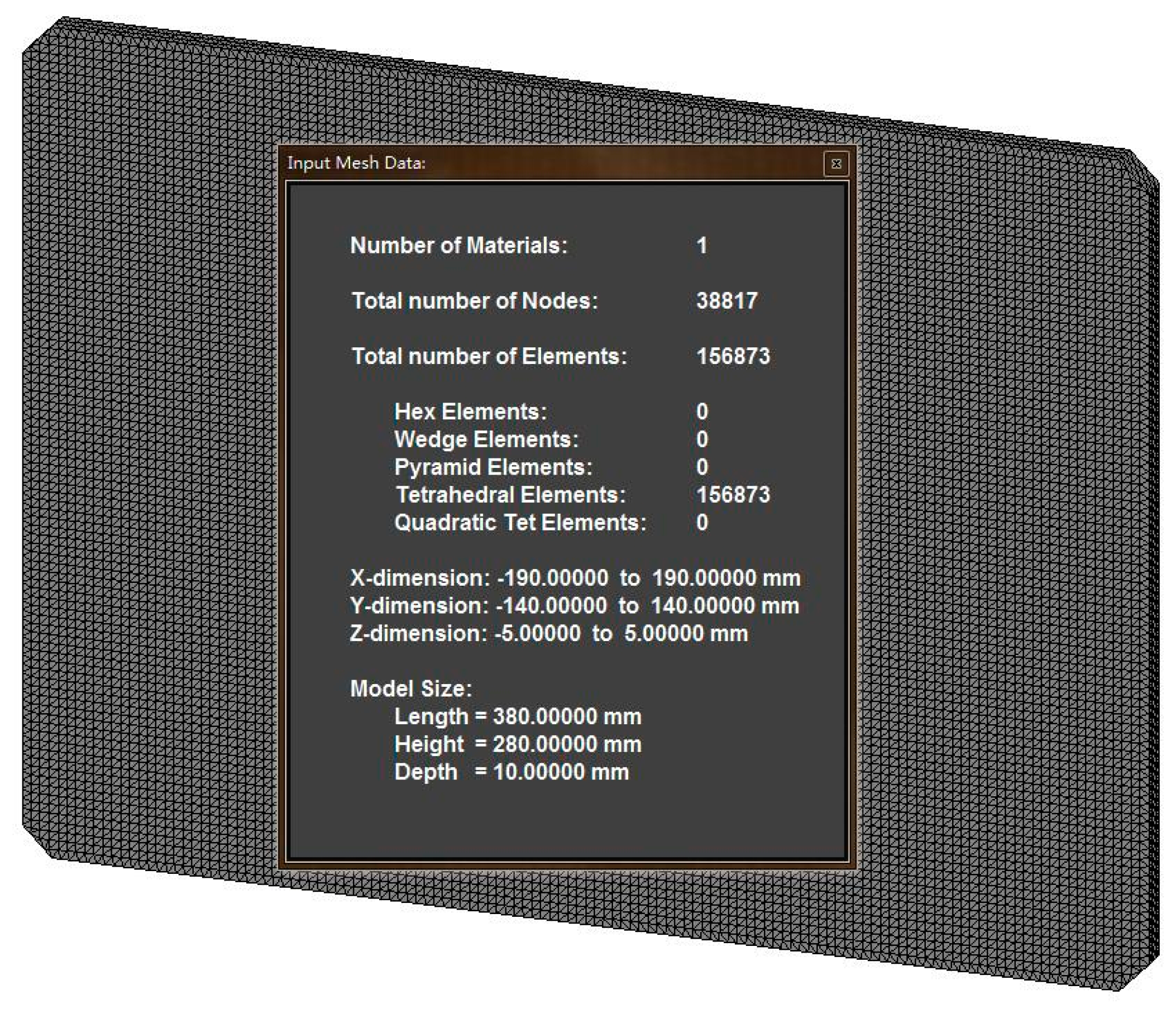
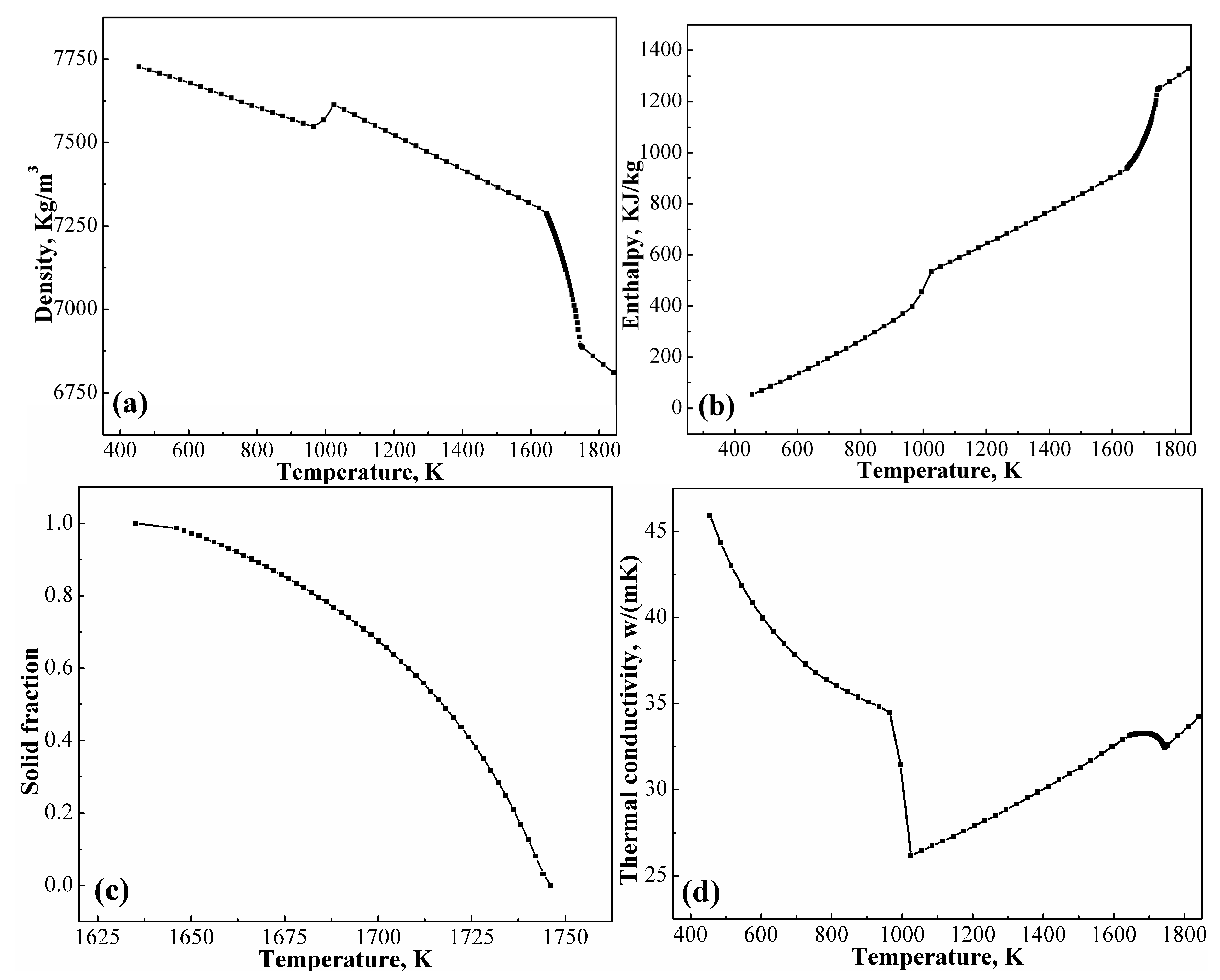

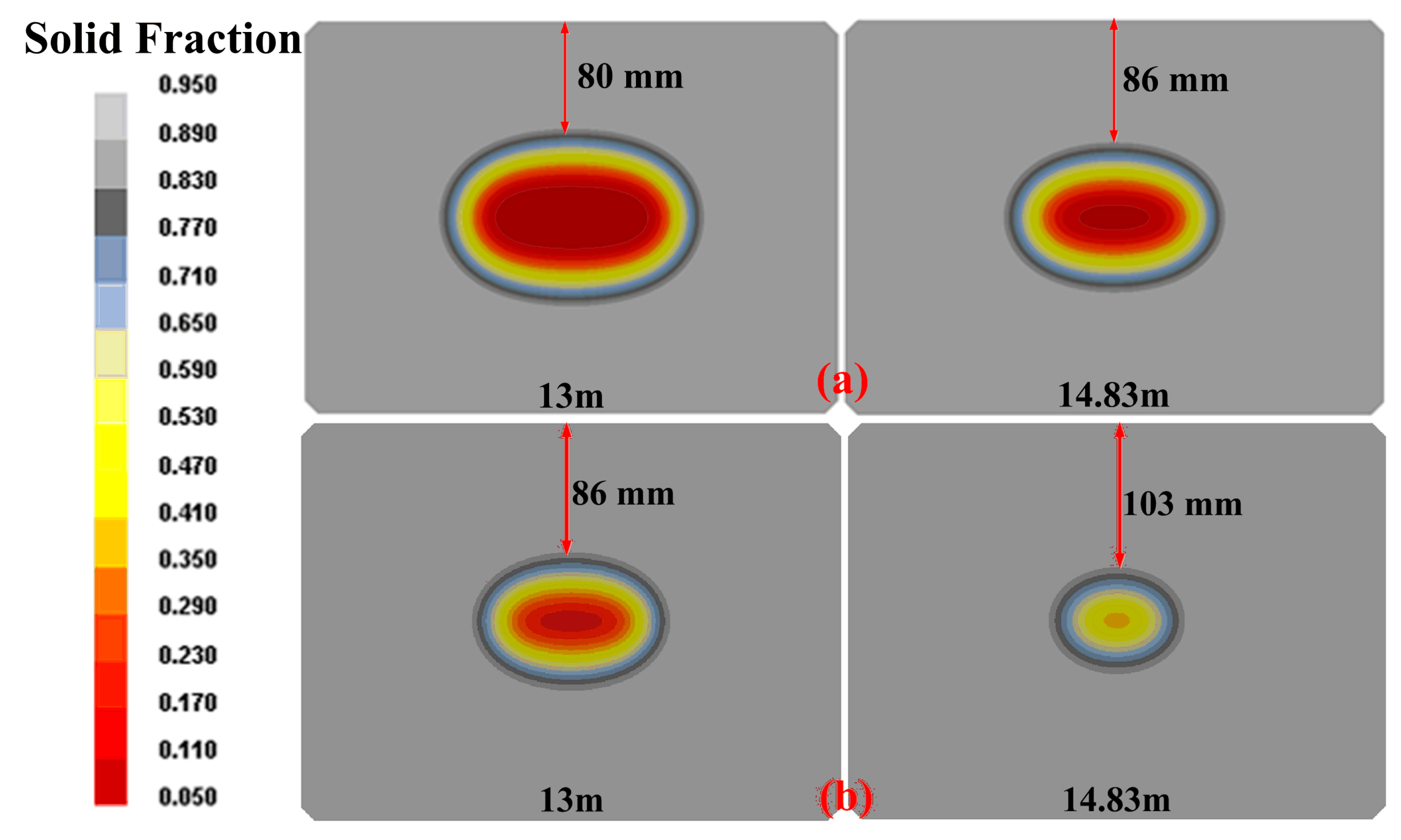
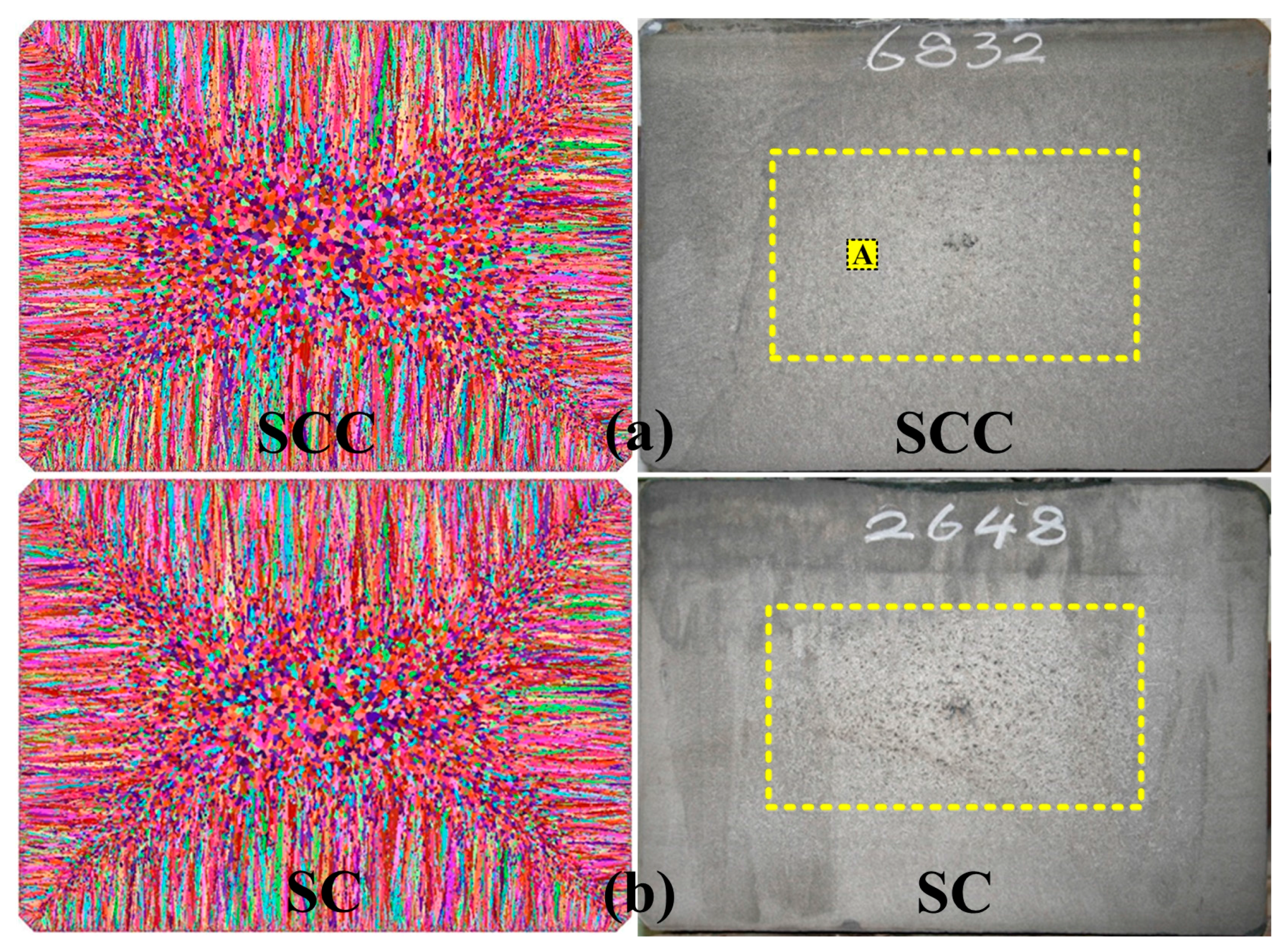
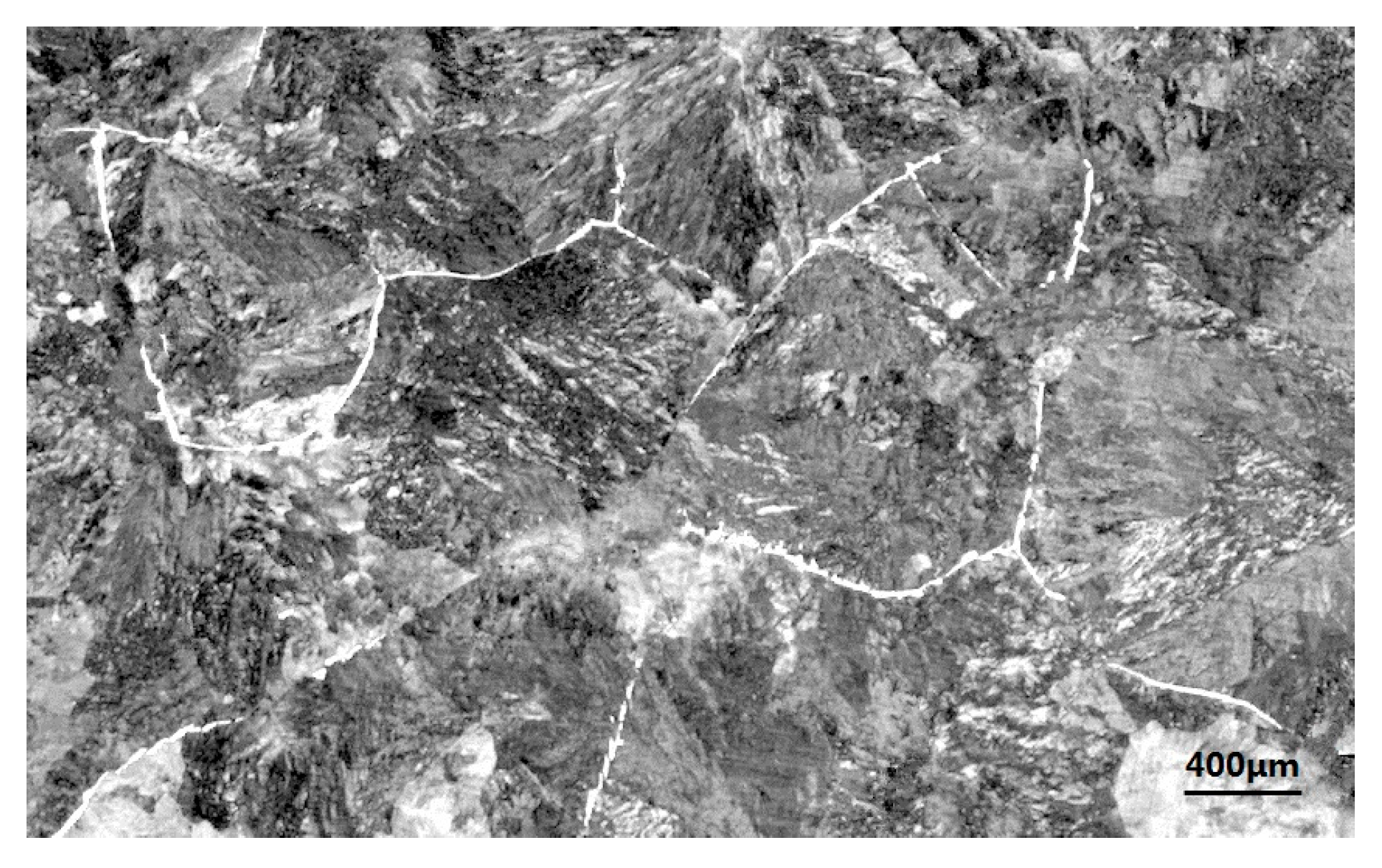
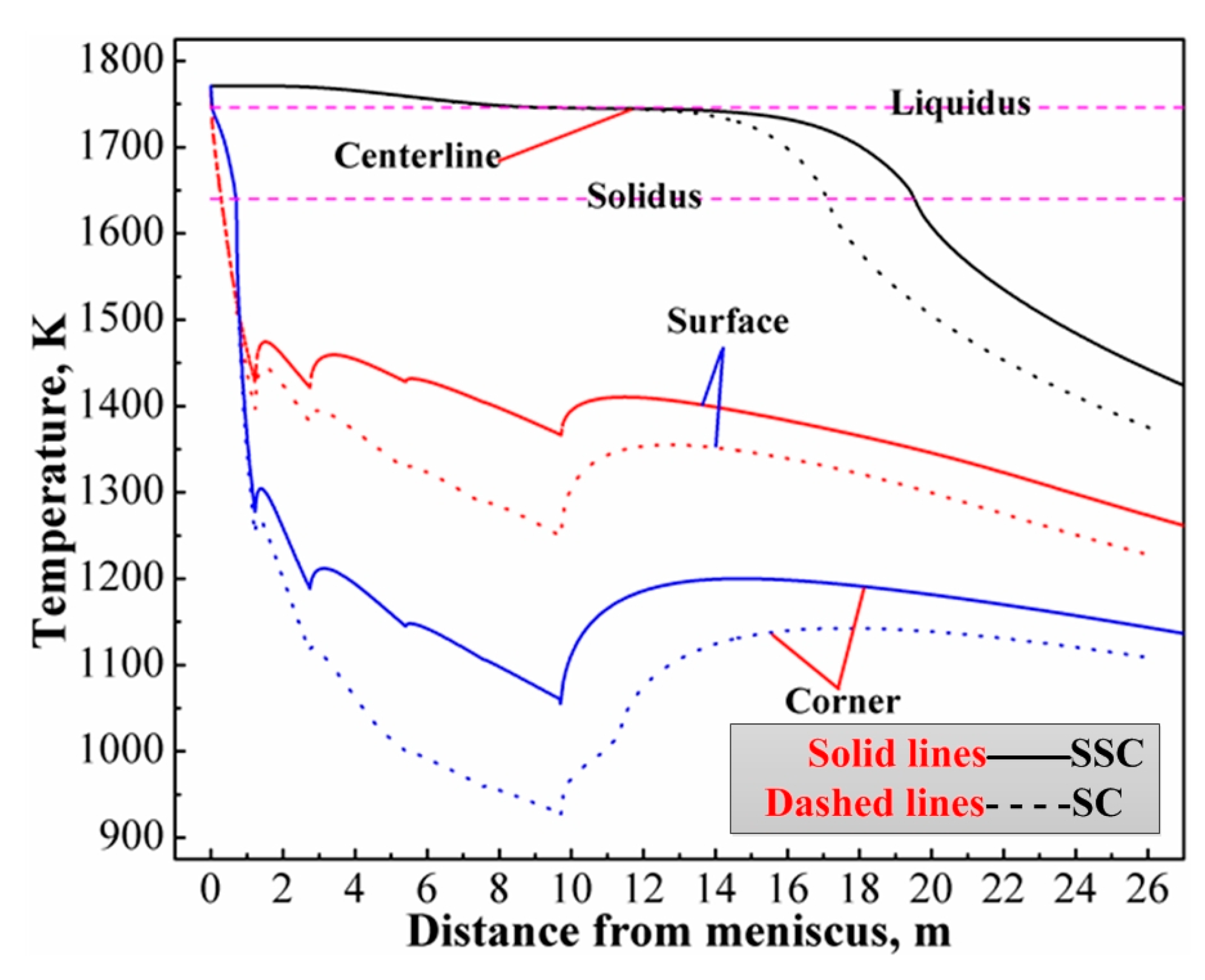
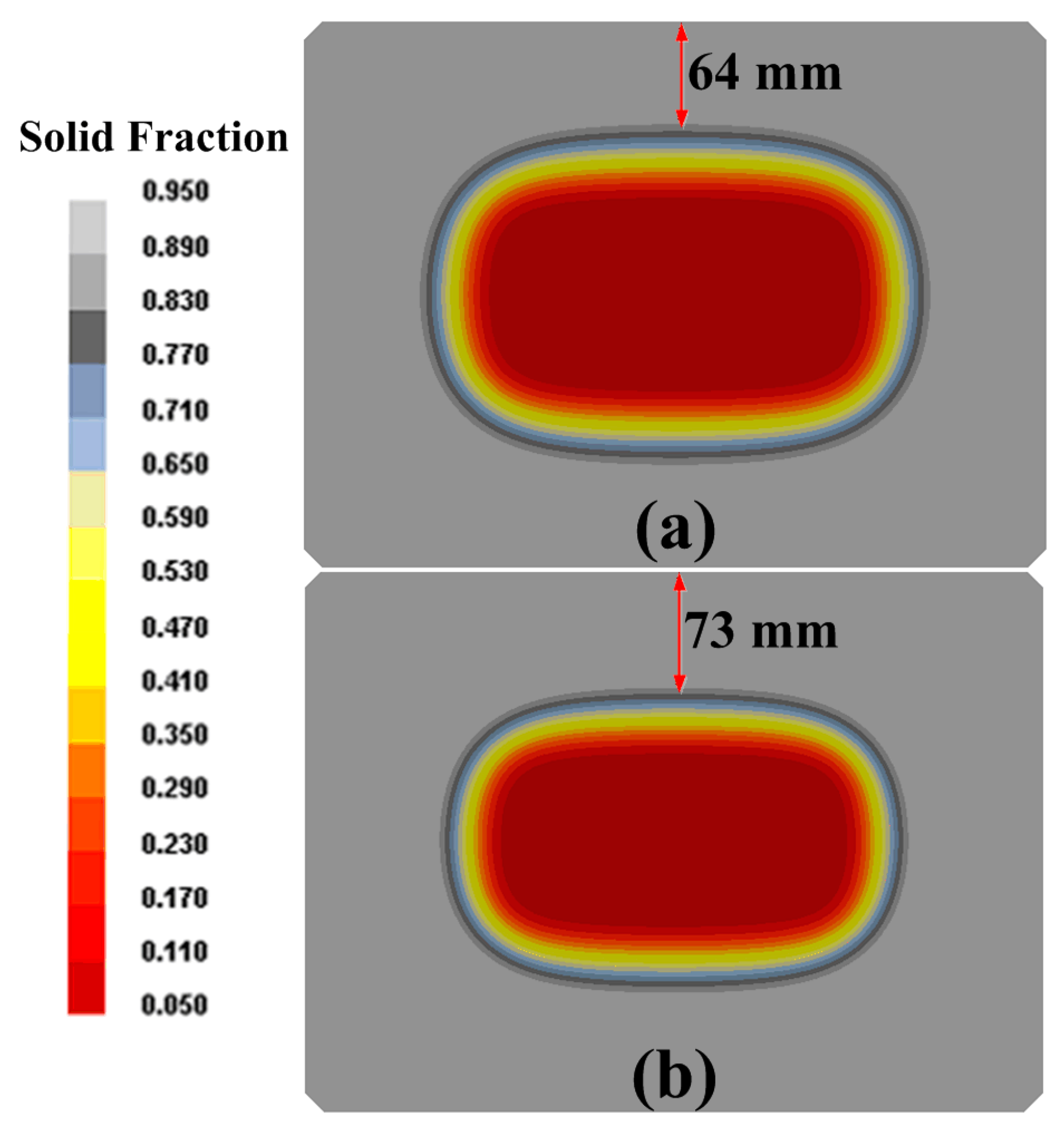
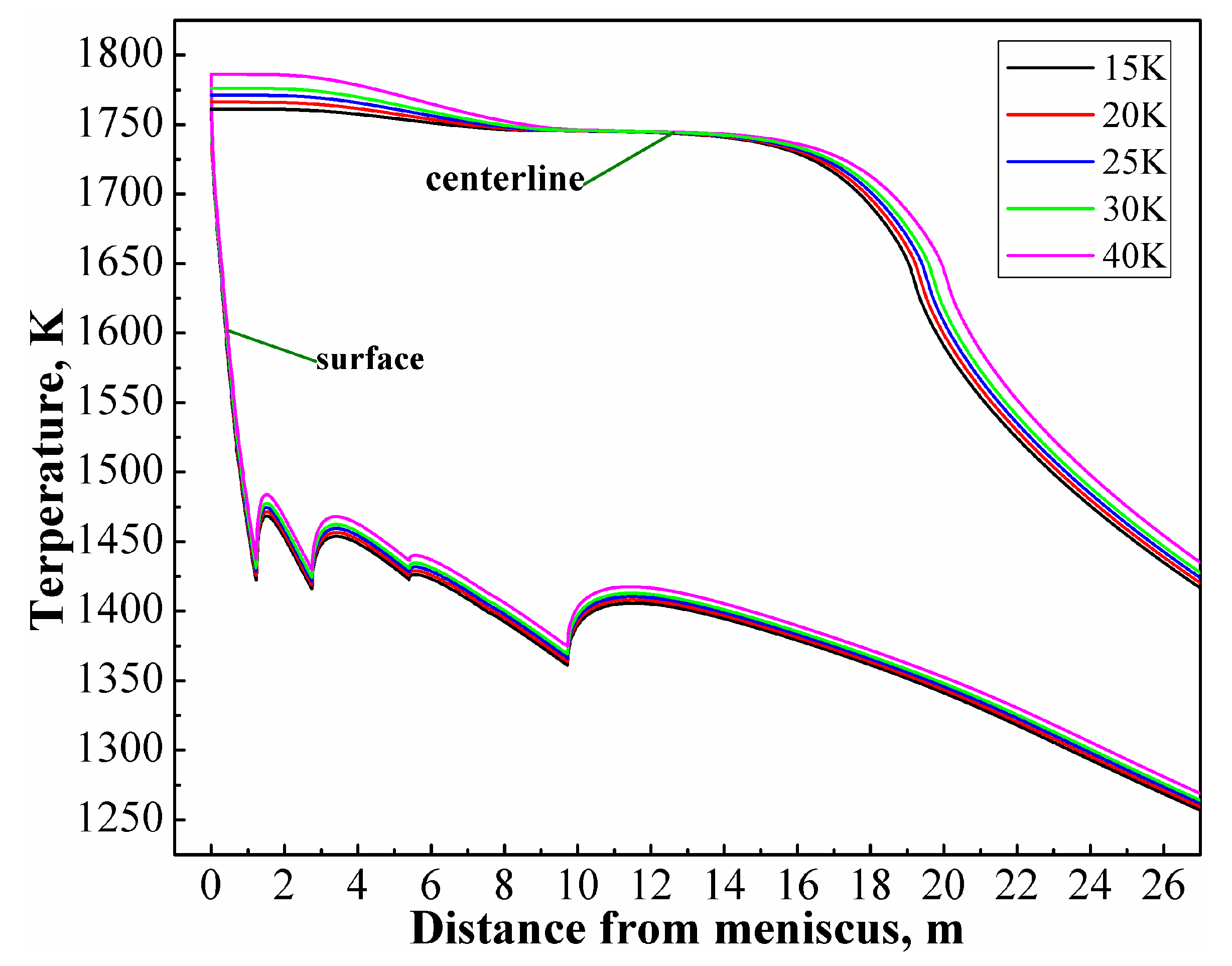
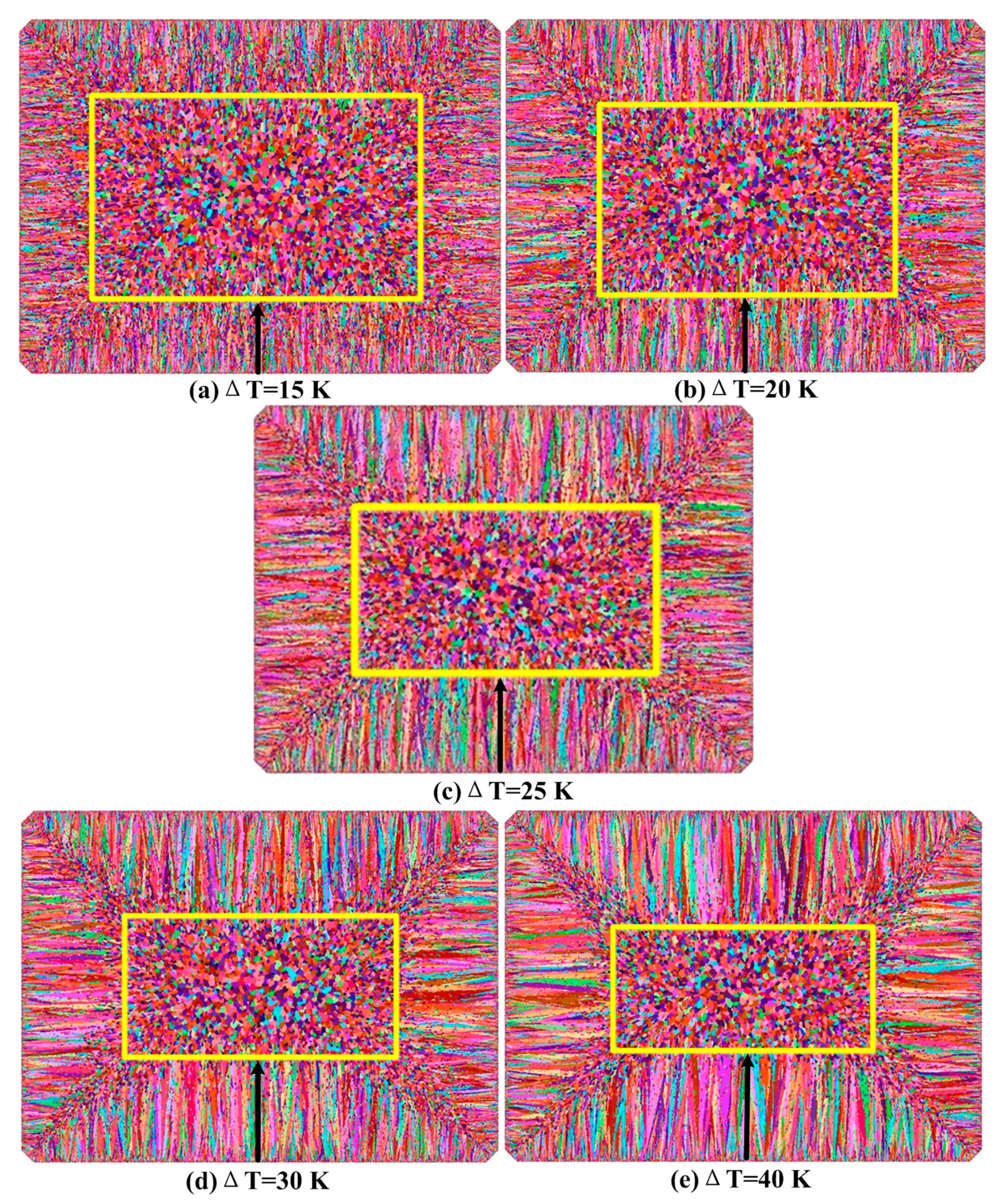
| Parameters | Value |
|---|---|
| Arc radius, m | 12 |
| Bloom cross section, mm2 | 380 × 280 |
| Chamfer mold dimension, mm | 10 |
| Effective height of mold, mm | 700 |
| Secondary cooling system | Zone I: spray cooling Zone II~V: air-mist cooling |
| Maximum metallurgical length, m | 26 |
| Casting speed, m/min | 0.63 |
| Water quantity in mold, L/min | 2600 |
| End of secondary cooling zone, m | 9.72 |
| Secondary cooling water rate, L/kg | 0.365 for SC, 0.198 for SSC |
| Element | c0, % | m | k | D, m2/s | Γ, m·K |
|---|---|---|---|---|---|
| C | 0.725 | −78 | 0.34 | 1.1 × 10−8 | 3 × 10−7 |
| Si | 0.355 | −21 | 0.05 | 3.5 × 10−9 | |
| Mn | 0.985 | −5 | 0.68 | 2.4 × 10−9 | |
| P | 0.014 | −34 | 0.06 | 4.7 × 10−9 | |
| S | 0.002 | −40 | 0.025 | 4.5 × 10−9 |
| Parameters | ΔTs,max, K | ΔTs,σ, K | ns | ΔTv,max, K | ΔTv,σ, K | nv | a2 | a3 |
|---|---|---|---|---|---|---|---|---|
| Value | 1 | 0.1 | 1 × 108 | 3.5 | 1 | 1 × 109 | 2.343 × 10−6 | 2.7737 × 10−6 |
| Condition | Position, m | Measured, mm | Simulated, mm | Error, % | Liquid Core Length, m |
|---|---|---|---|---|---|
| SCC | 13.00 | 83 | 80 | 3.6 | 19.69 |
| 14.83 | 88 | 86 | 2.3 | ||
| SC | 13.00 | 89 | 86 | 3.4 | 17.23 |
| 14.83 | - | 103 | - |
| Condition | No. Grains | Mean Surf/m2 | Nl/m | Na/m2 | Mean Radius/m | Equiaxed Ratio % |
|---|---|---|---|---|---|---|
| SSC | 16,357 | 1.623196 × 10−6 | 1.053651 × 103 | 6.160937 × 105 | 1.088757 × 10−3 | 28.7 |
| SC | 17,303 | 1.534888 × 10−6 | 1.091288 × 103 | 6.517252 × 105 | 1.065995 × 10−3 | 28.9 |
| ΔT | No. Grains | Mean Surf/m2 | Nl/m | Na/m2 | Mean Radius/m | Equiaxed Ratio % |
|---|---|---|---|---|---|---|
| 15 | 17,666 | 1.502860 × 10−6 | 1.071519 × 103 | 6.653978 × 105 | 1.025176 × 10−3 | 44.6 |
| 20 | 17,315 | 1.533325 × 10−6 | 1.061892 × 103 | 6.521773 × 105 | 1.036561 × 10−3 | 33.8 |
| 25 | 16,357 | 1.623195 × 10−6 | 1.053651 × 103 | 6.160938 × 105 | 1.088757 × 10−3 | 28.7 |
| 30 | 15,830 | 1.681266 × 10−6 | 1.030924 × 103 | 5.961813 × 105 | 1.101718 × 10−3 | 24.5 |
| 40 | 14,771 | 1.797409 × 10−6 | 9.854707 × 102 | 5.563564 × 105 | 1.127640 × 10−3 | 20.1 |
© 2017 by the authors. Licensee MDPI, Basel, Switzerland. This article is an open access article distributed under the terms and conditions of the Creative Commons Attribution (CC BY) license (http://creativecommons.org/licenses/by/4.0/).
Share and Cite
Fang, Q.; Ni, H.; Zhang, H.; Wang, B.; Liu, C. Numerical Study on Solidification Behavior and Structure of Continuously Cast U71Mn Steel. Metals 2017, 7, 483. https://doi.org/10.3390/met7110483
Fang Q, Ni H, Zhang H, Wang B, Liu C. Numerical Study on Solidification Behavior and Structure of Continuously Cast U71Mn Steel. Metals. 2017; 7(11):483. https://doi.org/10.3390/met7110483
Chicago/Turabian StyleFang, Qing, Hongwei Ni, Hua Zhang, Bao Wang, and Chengsong Liu. 2017. "Numerical Study on Solidification Behavior and Structure of Continuously Cast U71Mn Steel" Metals 7, no. 11: 483. https://doi.org/10.3390/met7110483





